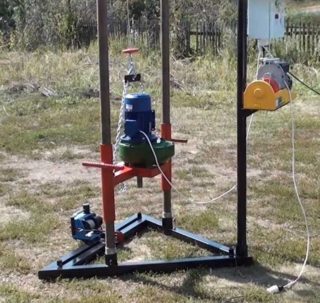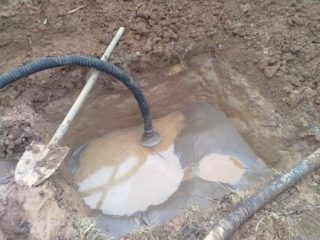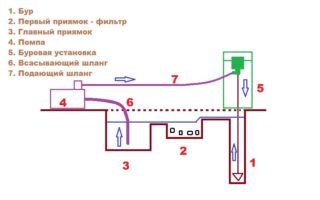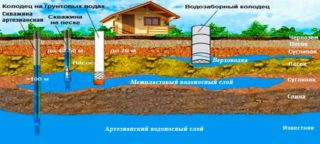For urban housing, uninterrupted obtaining of clean water is such a natural daily process that people do not even think about it. But in a country house or a suburban area, this may well become a problem. Indeed, in your own country house there are no public utilities that could take care of a constant water supply. Therefore, site owners have to independently install the water supply system, and one of the most effective ways is to drill wells with water under pressure.
Preparation for the drilling process

Do-it-yourself hydrodrilling of water wells is not an easy task, so it is unlikely that you can do without the help of specialists at all stages of drilling.
The owner of the site, who wants to carry out all the work with his own hands, must acquire professional equipment, since it is necessary in a complex technological process. No means at hand can replace it.
First of all, you need to find a small-sized drilling rig (MBU). You can get it in two ways: buy or rent from a specialized organization. This device is expensive, so it's best to contact a drilling company.
MBU is a structure with dimensions of approximately 3 m in height and 1 m in diameter. Its constituent parts:
- drilling tip;
- frame for fastening;
- a winch for lifting and lowering the drill;
- rotary engine;
- water pump;
- swivel;
- hand drill for penetrating the soil, it can be exploratory or petal;
- drill rods forming a string;
- drill string;
- system control unit;
- hose supplying water.
In the process of hydrodrilling water wells, you will need to continuously supply the installation with electricity, so prepare a current transformer. To pump the drilling solution, you will need a gasoline-powered motor pump.
Usually, during operation, a large mechanical load is created on the parts being driven, so it is worth choosing the most powerful power source possible. You also need a mud filtration system and a manual clamp.
Collecting information about the area
Find out more about the ecology of the area. Make sure there are no cemeteries, animal carcasses or other waste, including chemical waste, nearby. The presence of any toxic source in the immediate vicinity can render the water unfit for human consumption. Then it makes sense to use the well to obtain only technical water.
Site preparation

In the process of hydrodrilling, a lot of water is involved - from 10 to 20 cubic meters. m on average. Take care in advance that there is enough of it in the vicinity of the drilling site. It is better to install several containers of large volume made of metal or plastic, passing hoses to them. If containers of a suitable size are not available, dig a hole, compact the walls tightly and cover the entire surface with clay, after which water can be poured into it.
Place the drilling tool directly over where the hole is to be. An important point: MBU must be fixed strictly vertically, without the slightest deviation. Be inaccurate - you won't be able to install casing. The assembly procedure itself is simple, it takes 40-60 minutes for an unprepared person.
At a distance of 1–2 m from the MBU, 2 cuttings are made for drilling fluids with flushing. The filtration pit should be closer to the MBU, at a distance of approximately 1 meter and a volume of 0.5 cubic meters. m. A little further you need to dig the main pit of a larger size. A straight chute connects them so that drilling fluid can flow from one to the other.
Behind a large pit, you need to put a pump to power the MBU. Two hoses come out of it, one of which must be lowered into a large pit with drilling fluid, and the other must be connected to a swivel that feeds the solution to the bailer for drilling.
Drilling technology

If you are going to drill in sandy, loose soil, you will need a lot of water. Sand tends to quickly absorb large volumes of liquid. To minimize costs, the drilling fluid must be dense. To do this, mix water and clay in the pit. This principle will allow the solution, when it enters the bailer, to fill cracks and cracks, strengthening the walls of the hole.
When drilling wells with water under pressure, the technology assumes that the liquid is supplied to the thief by pumping it from the container with the help of hoses. You need to go deeper into the soil until you reach the aquifer. The average depth to be dug by the MBU is 50 m.
To avoid soil collapse, casing should be installed after pulling back the drill rod. It is better to do water drilling of wells with your own hands under a 125 mm pipe, since this is the most common diameter, and it is easier to find it. The casing material is plastic or metal. The first is preferable as it will last longer, easier to install and cheaper.
To keep the water clean, it is advisable to install a filter. Drill holes in one end of the casing, wrap it with geotextile or filter mesh, and then lower it down. When hydrodrilling water wells, it is necessary to clean the well from the solution after the process is completed. Place the head with the hose on the edge of the pipe, then supply clean water under pressure. After some time, there will be no sewage at the depth. It is only necessary to cover the bottom with gravel.
Pros and cons of DIY hydrodrilling
The advantage of hydrodrilling with MBU:
- No need to use expensive and heavy equipment that can ruin the landscape.
- The owner does not have to involve specialists in the work.
- It takes a minimum of effort and time to deliver the MBU to your drilling site. The unit can be lifted and carried by one person.
- The dimensions of the installation allow for manual drilling of wells with flushing even indoors, with ceilings not lower than 3.5–4 m.
- The complete process of drilling the bailer and installing the pipes takes 2 - 3 days.
Hydraulic drilling of wells using MBU is not suitable in places where the soil consists of dense and hard soils, if there are stones and gravel in the layers of the earth. In such a situation, water drilling is not effective. It will not help if the groundwater layer is deeper than 60–70 m. Therefore, when choosing a drilling method, study geodetic maps.









